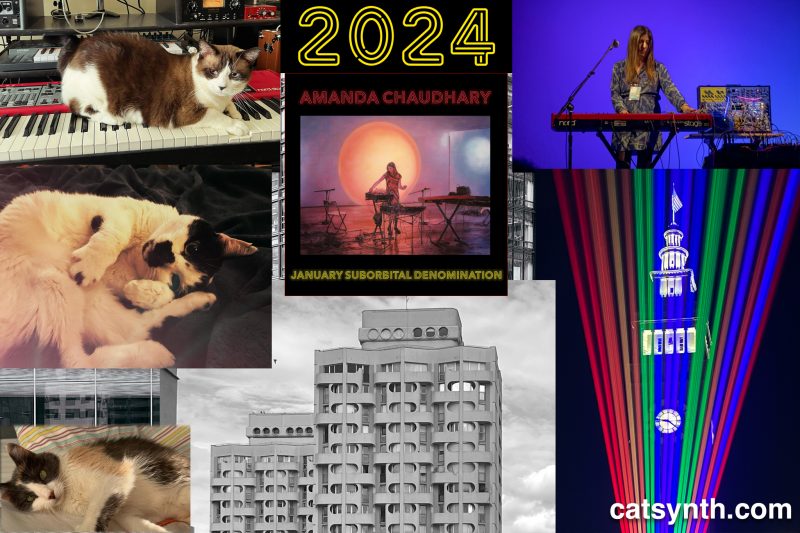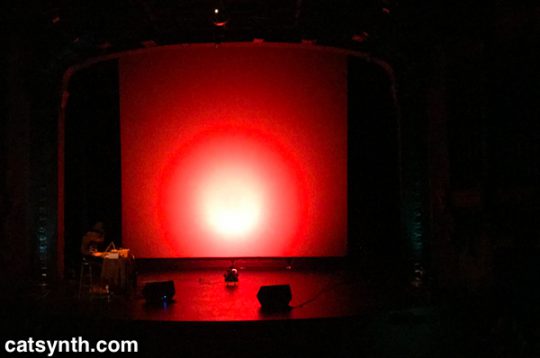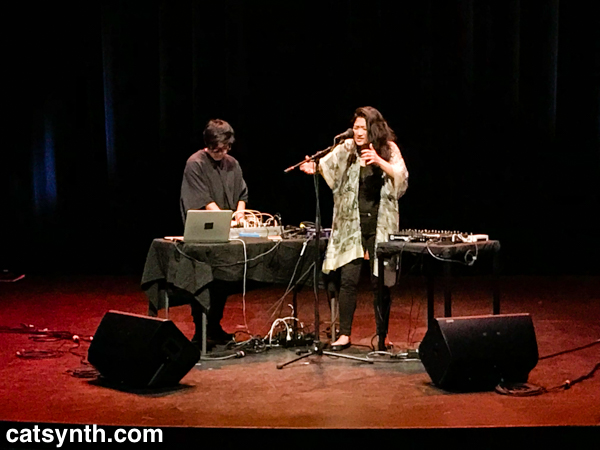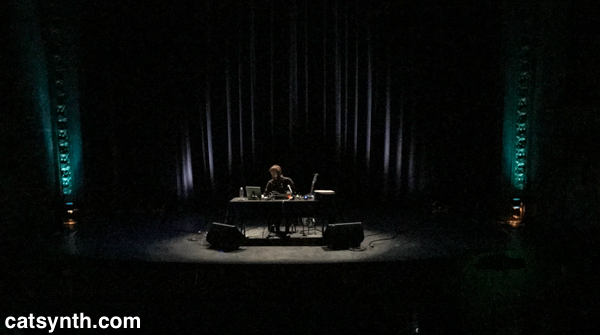Today we look back at the San Francisco Electronic Music Festival that took place earlier this month. Specifically, we review the opening concert which took place for the first time at SFMOMA. Appropriately for a collaboration with an institution focused on the visual arts, many of the pieces combined electronic music with graphics, video, or dance.
SFEMF is often a coming-together of people from the Bay Area electronic-music and new-music communities, and the audience was filled with familiar faces. Some even joined me in live tweeting with hashtag #sfemf during the concerts.
The concert opened with a solo performance by Sarah Howe entitled Peephole live electronic music and video.

[Sarah Howe. Photo: PeterBKaars.com.]
Howe describes her video work as “beautifully messy textures of low fidelity source material”. The result was quite mesmerizing, with ever-changing pixelated patterns on the large screen that pulsated and radiated, sometimes converging on seemingly recognizable images, sometimes completely abstract. The music featured highly processed electronic sounds taken from acoustic sources.
Next was Interminacy, a performance by Tom Djll and Tim Perkis based on “lost” John Cage stories, as “rescued from a Bay Area public-radio vault” (they did not say which public radio station). We hear Cage’s distinctive voice and speaking style, as recognized from his recorded interviews – see our post on John Cage’s 99th birthday for an example – with Djll and Perkis providing music in between the words supposedly derived from I-Ching. The music did cover a variety of synthesized electronic sounds, recording samples, and other elements, leaving plenty of silence as well.

[Tom Djll and Tim Perkis channel John Cage. Photo: PeterBKaars.com.]
It started out straightforward enough, but the narrations took a bit of a darker turn, which audience members may or may not have reacted to in amusement or horror. I personally fell into the former category, and considered this one of the more brilliant and well-crafted tributes I have heard in a long time. You can hear an excerpt from an earlier performance below (or here).
<a href=”http://djll.bandcamp.com/track/interminacy-excerpt” _mce_href=”http://djll.bandcamp.com/track/interminacy-excerpt”>Interminacy (excerpt) by Tom Djll/Tim Perkis</a>
The following performance featured Kadet Kuhne performing live with a video by Barcelona-based artist Alba G. Corral in a piece entitled STORA BJÖRN. Corral created visuals using the programming environment Processing that generated complex graphical patterns based on the constellation The Great Bear.

[Photo: PeterBKaars.com.]
Kuenhe’s music weaved in and out with the visuals in undulating but ever changing textures and timbres. The result of the combined music and visuals was quite meditative – at the same time, the visuals retained a certain analytical quality perhaps because of all elements based on connected lines. Glitchy elements in the music fed back into the lines and spaces.
Plane, a collaboration Les Stuck and Sonsherée Giles featured dance, visuals together with music. Stuck’s musical performance began against a video of Giles’ dancing that was created using a special camera technique and a limited palette of colors and effects to produce a low-resolution image with no sense of perspective. It did look a bit like a heat image of a moving body.

[Les Stuck. Photo: PeterBKaars.com.]
At some point during the performance, Giles herself appeared on the stage and the performance transitioned to live dance. Her movement was slow and organic, and she often stayed close to the ground, as if to make herself two-dimension like the images on the screen. Stuck’s music combined with the dance had a greater intensity than the previous music-and-visual performances on the concert, particularly in contrast to the far more delicate STORA BJÖRN that preceded it.
The concert concluded with a performance of Milton Babbit’s Philomel, performed by Dina Emerson. We lost both Milton Babbit and Max Mathews this year, and both were recognized with tribute performances during the festival. Philomel is perhaps the best known of Babbit’s famously complex compositions. You can hear an early recording of the piece in a tribute post here at CatSynth, as sung by soprano Bethany Beardslee. Emerson certainly had her work cut out for her in taking on this piece, but she came through with a beautiful and energetic performance.

[Dina Emerson performs Milton Babbit’s Philomel. Photo: PeterBKaars.com.]
The piece combines electronic sounds, live voice and processed recorded vocals weaved together in a fast-moving texture that preserves a narrative structure. One can alternately listen to the words as disjoint musical events or as part of the larger story. At some point, even while focused directly on Emerson’s presence, the live and recorded sounds began to merge together. The electronics often seem to match the timbre and pitch register of the voice, which aided in the illusion of a single musical source.
Overall, I thought it was a strong concert with a particularly strong finish. It also was somewhat shorter and faster paced, with no intermission or long pauses between sets, which I thought was quite effective.
I also attended the Saturday concert and will review that in an upcoming article.



















 ‘
‘















